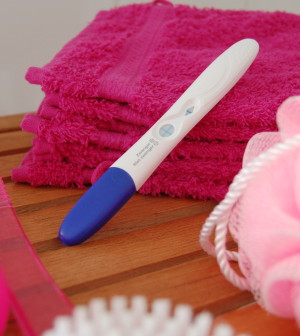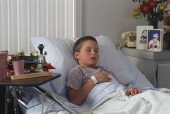- Skip Storing This Everyday Product in the Fridge Door
- Green Tea + B3 Pairing May Boost Brain Health
- Navigating Your Midlife Crisis: Embracing New Possibilities
- City Raccoons Showing Signs of Domestication
- Mapping the Exposome: Science Broadens Focus to Environmental Disease Triggers
- One Week Less on Social Media Linked to Better Mental Health
- Your Brain Changes in Stages as You Age, Study Finds
- Some Suicide Victims Show No Typical Warning Signs, Study Finds
- ByHeart Formula Faces Lawsuits After Babies Sickened With Botulism
- Switch to Vegan Diet Could Cut Your Greenhouse Gas Emissions in Half
Despite Major Progress, Some Childhood Cancers Are Still Killers


THURSDAY, Nov. 7Recent decades have seen huge strides in treating childhood cancer, but certain types of tumors remain difficult to treat and are often deadly.
That’s the frustrating fact at the heart of a meeting held this week by the American Association for Cancer Research. Pediatric cancer experts gathered in San Diego to discuss recent advances in understanding childhood tumors and the obstacles to improving kids’ care.
“The exciting thing is that we’re in an era of unprecedented discovery,” said Dr. John Maris, referring to recent research on the genetic underpinnings of childhood cancers. “But there’s still a huge amount of work to be done.”
One of the challenges in pediatric cancer research is that, thankfully, it’s relatively rare for children to develop cancer, said Maris, who directs the Center for Childhood Cancer Research at Children’s Hospital of Philadelphia.
In the United States, one or two out of every 10,000 kids develop cancer each year, according to the U.S. National Cancer Institute. It amounts to around 12,000 cases of childhood cancer and about 1,500 deaths annually.
Dr. James Downing, deputy director of St. Jude Children’s Research Hospital in Memphis, Tenn., said that’s a very small amount compared with the number of adults diagnosed with cancer.
As a result, Downing said, government funds and drug companies’ interests are largely focused on adult cancer.
“There are also very important practical considerations, because these are children,” Maris said.
Drugs of any kind typically are tested first in adults to help shield kids from toxic effects of experimental therapies. Safety concerns, plus limited resources and other issues, can slow progress.
“In pediatrics, we have to be very, very careful about prioritizing what we test,” Maris said.
In some cancer areas, there have been huge success stories. A major example is the blood cancer acute lymphoblastic leukemia (ALL), the most common type of cancer in children. In the early 1960s, only about 4 percent of U.S. children diagnosed with ALL were alive five years later. Now that number exceeds 90 percent.
Overall, the five-year survival rate from all childhood cancers combined has risen from around 60 percent in the mid-1970s to more than 80 percent in more recent years, according to the cancer institute.
Downing said, however, that cancer still kills more kids under age 15 than any other disease. And certain types remain stubbornly resistant to everything doctors have thrown at them.
“There’s a subset of cancers where we just have not made progress,” Maris said.
One example is a tumor of the brain stem called pontine glioma — a “terrible disease,” Downing said, that usually kills within a year.
Another example is neuroblastoma, a cancer of the nerve tissue in various parts of the body that usually arises before age 5. Many more kids survive the disease than in years past, but the chances depend in part on the child’s age.
Infants have a high cure rate, with about 90 percent alive five years later; that dips to 68 percent among children diagnosed between the ages of 1 and 4, according to the cancer institute.
The biology of a child’s neuroblastoma is also key. “We used to think all neuroblastomas were the same,” Maris said. “They’re not.”
Maris and his colleagues found that mutations in a gene called ALK are behind a rare form of neuroblastoma that runs in families.
An oral cancer drug — already tested and approved for certain cases of lung cancer in adults — targets ALK. In early trials, the drug, called crizotinib, led to remission in kids with the rare form of neuroblastoma and children with an uncommon, aggressive type of lymphoma.
At St. Jude, Downing and his colleagues have been working on a project to “decode” the genomes of more than 600 children with cancer in an attempt to gain a better understanding of the genetic origins of various tumors. They’ve found specific gene mutations in certain gliomas, neuroblastomas and rare subtypes of leukemia that they hope will someday lead to better treatments.
But even with highly curable cancers, such as ALL, safer treatments are needed. The chemotherapy, radiation and other therapies used to battle kids’ cancer can have unfortunate side effects years later — including other cancers and heart and lung damage.
“When you’re talking about children, a cure is not enough,” Maris said.
Both Maris and Downing pointed to better funding as a vital need. “We need advocacy at the legislative level to make sure pediatric cancers aren’t unwittingly discriminated against,” Maris said.
Public support — including donations to foundations supporting pediatric cancer research — can also help, Downing said. “This can’t get done without support from the general public,” he said.
More information
The National Cancer Institute has more on childhood cancer.
Source: HealthDay
Copyright © 2025 HealthDay. All rights reserved.










